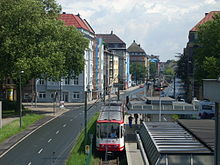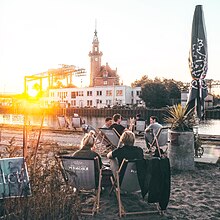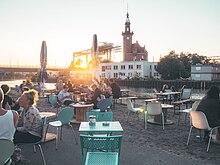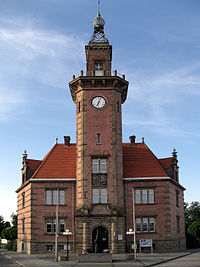Port of Dortmund
|
port
City of Dortmund
Coordinates: 51 ° 31 ′ 33 " N , 7 ° 26 ′ 34" E
|
|
|---|---|
| Height : | approx. 70 m above sea level NHN |
| Area : | 4.62 km² |
| Residents : | 18,292 (Dec. 31, 2019) |
| Population density : | 3,962 inhabitants / km² |
| Postal code : | 44147 |
| Area code : | 0231 |
| Statistical District : | 04 |
|
Location of the port in Dortmund
|
|
The Port of Dortmund is an inland port in the city center north of the city of Dortmund . The port is also the namesake of one of the three statistical districts in the city-center-north, which is considered to be a residential and business district with a high population density.
It was opened on August 11, 1899 by Kaiser Wilhelm II together with the Dortmund-Ems Canal . With effect from June 10, 1939, the city of Dortmund hived off its own port from the city administration and converted it into a stock corporation - the Dortmunder Hafen AG was founded.
It was badly damaged in the Second World War , but reopened in 1946 in order to be able to obtain urgently needed building materials for the reconstruction of the city. Today the northern port basins (Südhafen, Kohlenhafen and Petroleumhafen) are one of the largest logistics hubs in Europe, the Speicherstrasse at the city port is also used by cultural and gastronomic businesses. Since 2019, the city of Dortmund has been strengthening the settlement of start-ups and companies (see post-industrial urban development of the Dortmund port ).
History and present
Since the middle of the 19th century there were already considerations to build an artificial navigable waterway to the North Sea. In the course of industrialization, which had meanwhile also started in Dortmund , business-oriented expert groups took up the discussion about the sewer project again.
However, it would be another 40 years before the city of Dortmund was able to start building canals and ports. After the initial canal planning had provided for a route in an east-west direction, from the Rhine to the Weser, the more recent designs were based on the shortest route between the North Sea and the eastern Ruhr area.
The construction of the Dortmund port on the Dortmund-Ems Canal began in 1895 on the northern edge of what was then the urban area of Dortmund on the area of Unionvorstadt , a factory settlement of the Dortmund group , which made the settlement of 40 buildings into a residential enclave in the middle of the port area.
Responsible for the canal project was the royal canal construction commission, which was subordinate to the Prussian Ministry for Public Works and which, from 1890, organized and controlled the construction of the Dortmund-Ems canal from Münster . The groundbreaking ceremony for the construction of the Dortmund harbor took place on October 9, 1895. After almost three years of construction, the Dortmund port was largely completed, initially with five port basins: Canal port, city port, southern port, coal port and petroleum port. The costs for the port of Dortmund amounted to 6.43 million Reichsmarks including the more than 20 kilometers of track system.
In 1899 the port was opened by Kaiser Wilhelm II . In the 1920s and 30s, the port, which is mainly used for handling grain, coal and ore, was expanded. Further port basins were created and the administrative infrastructure ( old port authority Dortmund ) expanded. Today, the port of Dortmund, the largest canal port in Europe, has ten port basins with a shore length of 11 km.
The port attained its greatest economic importance after the Second World War. In 1972 6.2 million tons of freight were handled here. Even the completion of a container port in 1987 could not stop the significant decline in the tonnage handled, caused by the closure of the coal and steel industries in Dortmund . In 1997, 2.6 million tons of iron ore were landed here, but this group of goods has now completely disappeared from the Dortmund port.
Now the former "water station of the coal and steel industry" has become a logistics and industrial area of great international importance. The handling of iron ore and coal is a thing of the past; today, the port of Dortmund, along with other locations, is responsible for supplying the Rhine-Ruhr region with around 10 million inhabitants.
The port area gained nationwide media attention when an environmental scandal about the improper disposal of PCB- contaminated transformers by the company Envio was uncovered in 2010 . The decontamination of the company premises was completed at the end of 2018.
Harbor district as a residential location

The harbor district, like large parts of Dortmund's northern part , emerged at the turn of the century as a typical, densely built-up workers' residential area in perimeter block development with large, park-like open spaces. While the southern part of the district is densely built, the development loosens towards the north. Despite extensive destruction in World War II, many old buildings have been preserved around the port. Due to the low rents and the proximity to the city center, the quarter is increasingly being chosen by students, freelancers, artists and creative entrepreneurs as a place to live and work. Due to the expanding gastronomic offer and the settlement of creative companies, the district is occasionally referred to as the trendy district in the Ruhr area . In this process, an increase in the number of inhabitants and rising rental and real estate prices for existing condominiums from 896 € / sqm to 1035 € / sqm could be observed within a few years.
Population development
| year | 1987 | 2003 | 2008 | 2013 | 2016 | 2017 | 2018 | 2019 |
|---|---|---|---|---|---|---|---|---|
| Residents | 18.123 | 17,403 | 16,843 | 17,566 | 18,487 | 18,502 | 18,466 | 18,292 |
statistics
Structural data of the population in the Hafen district:
- Minor quota: 19.2% [Dortmund average: 19.4% (2016)]
- Old age quota: 17.1% [Dortmund average: 30.0% (2016)]
- Proportion of foreigners: 43.8% [Dortmund average: 18.2% (2018)]
- Unemployment rate: 19.6% [Dortmund average: 11.0% (2017)]
The average income is around 40% below the Dortmund average.
Development of the port of Dortmund
For more than ten years, a development of the city harbor basin along Speicherstraße at the old harbor office based on the model of the Kreativkai in Münster has been considered. The search for investors was not very successful, however, despite extensive planning over the years, due to existing rental agreements that slowed down development. Since 2015, however, local politicians have been increasingly promoting the conversion of sections of the city harbor. The Speicherstraße in the northern port area was to be moved about 20 meters to the east, which meant that larger, more attractive building plots for office buildings were to be created directly on the canal.
The development company d-port21, a subsidiary of DSW21 and Dortmunder Hafen AG, was founded to attract companies from the creative and digital industries to the Dortmund harbor. The city is thus following a model that has already proven itself within the framework of the Phoenix Lake project . The development project is financed by the European Regional Development Fund , the federal government , the state of North Rhine-Westphalia and the city of Dortmund . Investments in the three-digit million range are expected.
The plans drawn up by d-port21 include, among other things, the settlement of start-ups and companies in the southern Speicherstrasse . Cafés and restaurants are to be built on the planned bank promenade . The port of Dortmund is to be stabilized as an industrial and economic area and to create 3,000 to 5,000 jobs through the settlement of companies .
After the plans for the development of the port became known, residents founded the port initiative to support the preservation of the port as a public space .
Architectural monument of the old port authority
→ Main article: Old Port Authority Dortmund
For the inauguration of the Dortmund port on August 11, 1899 by Kaiser Wilhelm II, the old port authority was built in the port . A two-storey building with a large front tower was built on a hexagonal floor plan based on plans by city building officer Friedrich Kullrich, which is not by chance reminiscent of a lighthouse. In addition to the external shape, this association is reinforced by the way around the tower core. In the tower, an “imperial room” was set up, the outer parapet of which shows the coats of arms of the cities of Dortmund and Emden carried by dolphins .
The iron lattice construction originally attached to the tower crown was dismantled around 1930 due to dilapidation and was only replaced by a reconstruction made of hot-dip galvanized steel in 1986, after the interior of the building had already been restored in 1982/1983. The ball on the spire is to be understood as a time ball , the top serves as a flagpole. In 1986, in addition to the crowning of the tower, the entire exterior was also restored.
Until 1962, the old port authority was the seat of the Dortmunder Hafen AG . The building was used in 2007 by the water police and for an exhibition on the theme of ports and shipping.
The old port office is located on Sunderweg in the transition to Kanalstrasse. The central location in the center of the canal port is further emphasized by the fact that the bridge over the city port runs directly towards the tower and the carriageway does not swerve to the west until shortly before the building. The building, which is illuminated at night, is visible from afar due to the raised building site.
The old port authority, which was already planned to be demolished in the 1950s, is now one of the landmarks of Dortmund's northern part of the city and, like the port of Dortmund, part of the route of industrial culture .
Harbor and canal as a sports and leisure area
In addition to the aforementioned port gastronomy and the Federal Rowing Center , various schools and clubs use the canal as a boating area. Examples include the Hansa rowing club from 1898 and the Germania rowing club from 1929, as well as the canoeing department of the Free Sports Club from 1898 FS-98. Starting from the port, the Dortmund-Ems-Canal cycle path extends along the canal towards Waltrop and further into the Münsterland. The canal banks are increasingly used by bathers and for barbecues in summer.
The port as a business location
In 2007, 3.2 million tons of freight were handled in the port of Dortmund. This means an increase of 7.1% compared to 2006. This increase is above all a success of the Dortmund “CTD” container terminal , which is increasingly used. In 2007, containers with a tonnage of 701,000 tons were handled in Dortmund . In January 2009 the third container bridge was put into operation in the port by Container Terminal Dortmund GmbH . In February 2016, a new bimodal container terminal was put into operation on Franz-Schlüter Strasse. The turnover according to product groups was as follows:
| Product group | Tonnage 2005 | Tonnage 2006 | Tonnage 2007 | Tonnage 2008 | Tonnage 2009 | Tonnage 2010 | Tonnage 2011 | Tonnage 2014 | Tonnage 2016 | Tonnage 2017 | Tonnage 2018 | Tonnage 2019 |
|---|---|---|---|---|---|---|---|---|---|---|---|---|
| Building materials | 982,000 t | 934,000 t | 990,000 t | 776,000 t | 649,000 t | 690,000 t | 540,200 t | 367,000 t | 265,000 t | 265,000 t | ||
| Mineral oils | 621,100 t | 647,000 t | 538,000 t | 570,000 t | 571,000 t | 630,000 t | 566,000 t | 558,000 t | 459,000 t | 349,000 t | ||
| iron and Steel | 294,400 t | 334,000 t | 401,000 t | 355,000 t | 152,000 t | 147,000 t | 256,000 t | 199,000 t | 147,000 t | 101,000 t | ||
| scrap metal | 219,800 t | 216,000 t | 231,000 t | 271,000 t | 189,000 t | 160,000 t | 219,000 t | 291,000 t | 225,000 t | 250,000 t | ||
| Coal and coke | 148,000 t | 272,000 t | 166,000 t | 170,000 t | 88,200 t | 81,000 t | 100,100 t | 109,000 t | 15,000 t | 67,000 t | ||
| Other groups of goods | 442,600 t | 557,000 t | 701,000 t | 796,000 t | 767,700 t | 810,500 t | 864,300 t | 787,000 t | 764,000 t | 1,103,000 t | ||
| total | 2,707,900 t | 2,960,000 t | 3,027,000 t | 2,938,000 t | 2,416,900 t | 2,518,500 t | 2,545,600 t | 2,940,000 t | 2,734,000 t | 2,310,000 t | 1,875,000 t | 2,135,000 t |
Source: Dortmunder Hafen AG
literature
- Ute S. Iserloh: The Dortmund port - Europe's largest canal port . 1st edition. JP Bachem Verlag, Cologne 2005, ISBN 3-7616-1910-3 , p. 47 .
Web links
- Website of the port of Dortmund
- Photo project about the port of Dortmund
- Dortmund - Europe's largest canal port. Westphalia regional
- Description of this sight on the route of industrial culture
- Early documents and newspaper articles on the port of Dortmund in the 20th century press kit of the ZBW - Leibniz Information Center for Economics .
Individual evidence
- ^ City of Dortmund: Population by gender and nationality in the statistical districts on December 31, 2019. (PDF) Department of Statistics, 2019, accessed on June 21, 2020 .
- ^ History of Dortmund harbor. Hafen Dortmund AG, December 9, 2018, accessed on July 10, 2017 .
- ↑ History On the way to the new quarter. Hafen Dortmund AG, December 9, 2018, accessed on July 10, 2017 .
- ^ History of the port , accessed July 8, 2014
- ↑ PCB scandal in Dortmund: Envio manager in court . In: Spiegel Online . May 9, 2012 ( spiegel.de [accessed November 12, 2019]).
- ↑ Gregor Beushausen: The renovation of the Envio site at the Dortmund harbor should be completed in December. Retrieved November 12, 2019 .
- ↑ trendy district at Dortmund harbor. Westfälische Rundschau, July 7, 2017, accessed on July 10, 2017 .
- ^ Housing market report of the city of Dortmund. City of Dortmund, July 7, 2017, accessed on July 10, 2017 .
- ↑ Population structures annual report 2016 (PDF file)
- ↑ Population structures annual report 2016 (PDF file)
- ↑ Nationalities in the statistical districts as of December 31, 2018 (PDF file)
- ↑ Unemployment rates according to statistical districts on June 30, 2017 ( memento of the original from June 25, 2018 in the Internet Archive ) Info: The archive link was inserted automatically and has not yet been checked. Please check the original and archive link according to the instructions and then remove this notice. (PDF file)
- ↑ The trendy port of Dortmund. Westfälische Rundschau datum = 2017-07-07, accessed on July 10, 2017 .
- ↑ From Nordstadtblogger-Redaktion: Full house in the home port of Dortmund: optimism among the city, planners, investors, users and neighbors. October 2, 2017, accessed on November 12, 2019 (German).
- ↑ Digital Campus at the port is to create 5,000 jobs - the city founds a society. Retrieved November 12, 2019 .
- ↑ alexpressedo: Hafen AG and Gerber Architects present their visions for Speicherstraße - harbor promenade and 4,000 jobs. September 15, 2016, accessed on November 12, 2019 (German).
- ^ Economic development city of Dortmund (ed.): Real estate market Dortmund . Dortmund September 2017, p. 9 ( wirtschaftsfoerderung-dortmund.de [PDF]).
- ↑ Gerber_Demo. Retrieved November 12, 2019 .
- ↑ Dortmund: The north city is reinventing itself. January 9, 2019, accessed on November 12, 2019 (German).
- ↑ Dortmunder Hafen AG (Ed.): DOCK.Hafenmagazin . Dortmund April 2019, p. 5 ( dortmunder-hafen.de [PDF]).
- ↑ alexpressedo: Hafen AG and Gerber Architects present their visions for Speicherstraße - harbor promenade and 4,000 jobs. September 15, 2016, accessed on November 12, 2019 (German).
- ↑ Dortmund: The north city is reinventing itself. January 9, 2019, accessed on November 12, 2019 (German).
- ↑ Port Initiative - Who Owns the Port of Dortmund? Retrieved November 12, 2019 .
- ^ From Nordstadtblogger-Redaktion: Neighborly exchange: development, planning and perspectives of the quarter - Speicherstrasse in the north of the city. October 22, 2018, accessed on November 12, 2019 (German).
- ↑ Dortmund: The north city is reinventing itself. January 9, 2019, accessed on November 12, 2019 (German).
- ↑ Protest against port planning: Port initiative invites you to a large dance demo "Dreams under asphalt - make the city yourself!" September 5, 2019, accessed on November 12, 2019 (German).
- ↑ https://www.dortmunder-hafen.de/presse/mitteilungen/2016/neue-logistikdrehscheibe-am-dortmunder-hafen/
- ↑ https://www.ctddortmund.de/über-uns/
- ↑ a b c Dortmund port group - cover. In: https://www.dortmund.de/de/leben_in_dortmund/ausunsererstadt/stadtportraet/statistik/verkehr_2/index.html . City of Dortmund, accessed on August 9, 2020 .
- ↑ Peter Kleinort: Port of Dortmund is growing rapidly . In: Daily port report , February 5, 2015, p. 5
- ↑ Annual balance sheet: Dortmund harbor reports stable result for 2016. City of Dortmund, July 7, 2017, accessed on July 10, 2017 .










